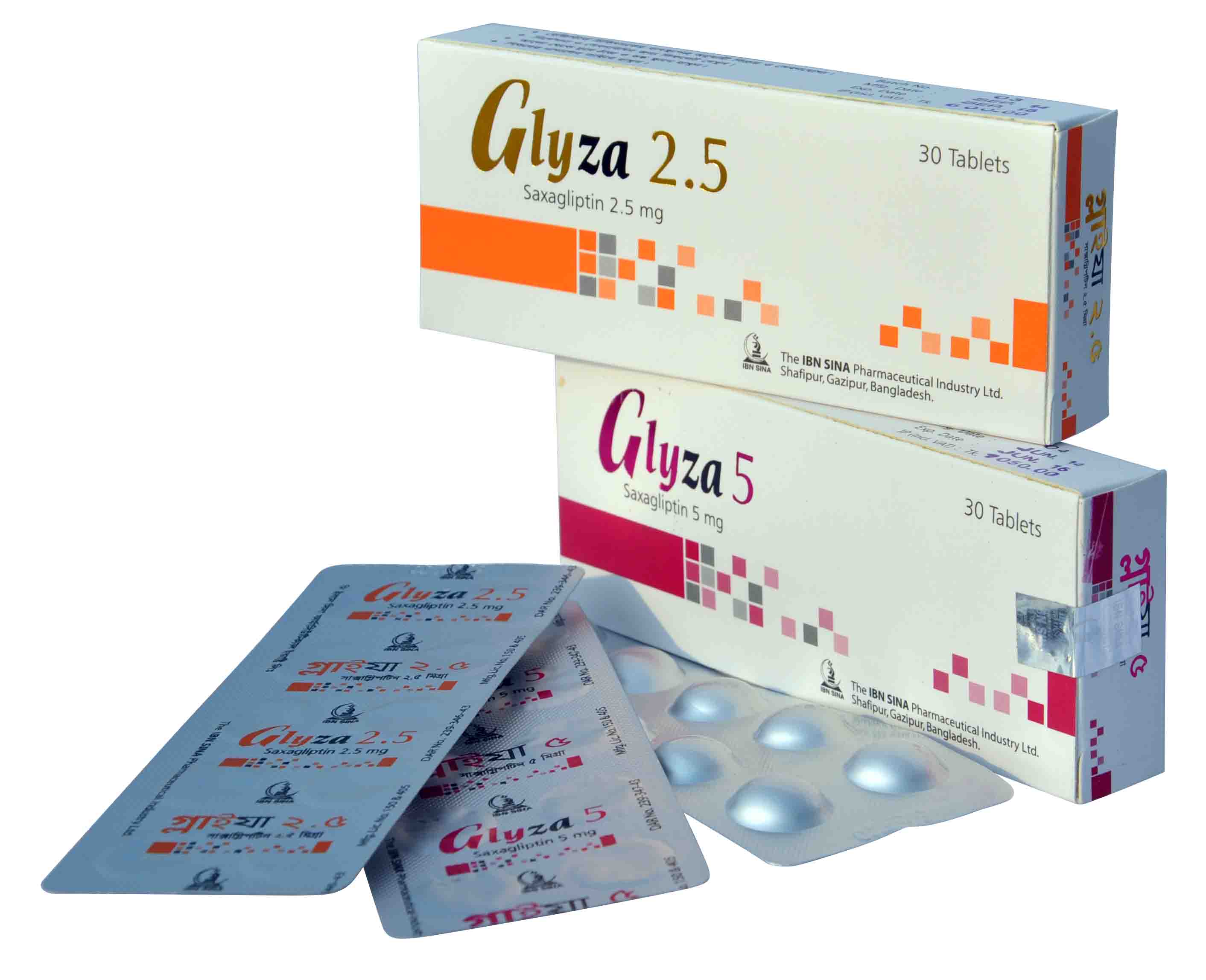
GLYZA
SAXAGLIPTIN HCL INN
| NAME | STRENGTH | PACK SIZE | DOSAGE FORM |
|---|---|---|---|
| GLYZA 2.5 MG | 2.5 MG | 30 S | TABLET |
| GLYZA 5 MG | 5 MG | 30 S | TABLET |
Glyza 2.5 Tablet: Each film coated tablet contains Saxagliptin 2.5 mg as Saxagliptin Hydrochloride INN.
Glyza 5 Tablet: Each film coated tablet contains Saxagliptin 5 mg as Saxagliptin Hydrochloride INN.
Saxagliptin is an orally-active inhibitor of the DPP4 enzyme. Saxagliptin is a competitive DPP4 inhibitor that slows the inactivation of the incretin hormones, thereby increasing their bloodstream concentrations and reducing fasting and postprandial glucose concentrations in a glucose-dependent manner in patients with type 2 diabetes mellitus.
Glyza is indicated as an adjunct to diet and exercise to improve glycemic control in adults with type 2 diabetes mellitus.
The recommended dose is 2.5 mg or 5 mg once daily taken regardless of meals. Patients with Renal Impairment: No dosage adjustment is recommended for patients with mild renal impairment (creatinine clearance [CrCl] >50 mL/min). The dose is 2.5 mg once daily for patients with moderate or severe renal impairment, or with end-stage renal disease (ESRD) requiring hemodialysis (creatinine clearance [CrCl] < 50 mL/min). Saxagliptin should be administered following hemodialysis. Saxagliptin has not been studied in patients undergoing peritoneal dialysis. Because the dose of Saxagliptin should be limited to 2.5 mg based upon renal function, assessment of renal function is recommended prior to initiation of Saxagliptin and periodically thereafter. Renal function can be estimated from serum creatinine using the Cockcroft-Gault formula or Modification of Diet in Renal Disease formula.
Saxagliptin is contraindicated in patients with known hypersensitivity to this drug.
Use with Medications Known to Cause Hypoglycemia: Insulin secretagogues, such as sulfonylureas, cause hypoglycemia. Therefore, a lower dose of the insulin secretagogue may be required to reduce the risk of hypoglycemia when used in combination with Saxagliptin. Macrovascular Outcomes: There have been no clinical studies establishing conclusive evidence of macrovascular risk reduction with Saxagliptin or any other antidiabetic drug.
Adverse reactions reported in >5% of patients treated with Saxagliptin and more commonly than in patients treated with placebo are: upper respiratory tract infection, urinary tract infection, and headache. Peripheral edema was reported more commonly in patients treated with the combination of Saxagliptin and a thiazolidinedione (TZD) than in patients treated with the combination of placebo and TZD. Hypoglycemia was reported more commonly in patients treated with the combination of Saxagliptin and sulfonylurea than in patients treated with the combination of placebo and sulfonylurea. Hypersensitivity-related events (e.g., urticaria, facial edema) were reported more commonly in patients treated with Saxagliptin than in patients treated with placebo.
Pregnancy: Category B. There are no adequate and well-controlled studies in pregnant women. Saxagliptin, like other antidiabetic medications, should be used during pregnancy only if clearly needed. Nursing Mother: It is not known whether Saxagliptin is secreted in human milk. Because many drugs are secreted in human milk, caution should be exercised when Saxagliptin is administered to a nursing woman.
Dosage adjustment of Saxagliptin is not recommended in case of rifampin, diltiazem, amprenavir, aprepitant, erythromycin, fluconazole, fosamprenavir, grapefruit juice, and verapamil. The dose of Saxagliptin should be limited to 2.5 mg when coadministered with ketoconazole, atazanavir, clarithromycin, indinavir, itraconazole, nefazodone, nelfinavir, ritonavir, saquinavir, and telithromycin.
In a controlled clinical trial, once-daily, orally-administered Saxagliptin in healthy subjects at doses up to 400 mg daily for 2 weeks (80 times the MRHD) had no dose-related clinical adverse reactions and no clinically meaningful effect on QTc interval or heart rate. In the event of an overdose, appropriate supportive treatment should be initiated as dictated by the patient's clinical status. Saxagliptin and its active metabolite are removed by hemodialysis (23% of dose over 4 hours).
Store at (at 20-25°C). Protect from light and moisture. Keep out of the reach of the children.
Glyza 2.5 Tablet: Each box contains 3x10's tablet in Alu-Alu blister pack.
Glyza 5 Tablet: Each box contains 3x10's tablet in Alu-Alu blister pack.
